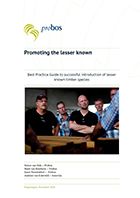Promoting The Lesser Known
Sietze van Dijk, Mark van Benthem, Joyce Penninkhof (Probos), Andries van Eckeveld (Innovita), December 2020
Best Practice Guide to successful introduction of lesser known timber species
This Best Practice Guide “Promoting The Lesser Known” is an outcome of the project ‘Market introduction of Surinamese Lesser Known Timber Species (LKTS) in Europe’. The aim of the project is to strengthen sustainable management of Suriname tropical forests by: i) bringing more balance in the forest composition and the tree species to be harvested; ii) increasing the economic value of these forests and iii) creating a market for quality timber in line with its potential uses.
The guide is based on interviews and experiences gathered during the project implementation and additional literature review and was supported by the European Sustainable Tropical Timber Coalition’s (STTC) Lesser Known Species Consortium (2012-2016) and the project ‘Market introduction of Surinamese Lesser Known Timber Species in Europe’(2015-2018). Besides the STTC, the making of this guide was financially supported by the Dutch Centre for Imports from Developing Countries (CBI), the Sustainable Trade Initiative (IDH) and the Netherlands Embassy in Paramaribo, Suriname.
The selection of potential new species goes through subsequent steps in which the first relates to the forest: an assessment of the available volume and stem quality of the LKTS considered to be included in harvesting and placed on the (international) market. Local knowledge on the processing and use of these new timbers may provide valuable information too. Next criteria for selection are based on extensive literature review and the consultation of existing databases. All these steps aim to limit the number of species for further research, realizing the high cost, time and effort these these will take.
Next, representative samples need to be send to both specialized laboratories for technical research on wood properties and potential buyers for the practical-scale testing. Also, in this early stage already, start to create potential buyers’ interest and build business relation (if not existing yet) and make sure you are aware of the import requirements of specific countries or regions. Verified legal sourcing of wood and wood products is the most common, but other may apply as well.
Subsequent chapters of the report deal with partnerships for practical-scale testing and the marketing. Suggestions for possible partners and organizations to liaise with are listed, several strategies and tools for the promotion and marketing of new timber species are described. Here the concepts of comparison, grouping and substitution of timber species are explained, but also how to make use of existing timber procurement policies in buyers’ countries and/or the CSR policies of potential clients. To conclude, the importance of trustworthy communication in marketing and the many tools, both web-based and the use of media and free publicity, are described.
The final chapter of this guide may be considered the most important. Here we present our experiences in implementing this project and the lessons we learned from it. And, avoiding similar pitfalls that may be on your way when engaging in alike LKTS projects. Fascinating reading!



